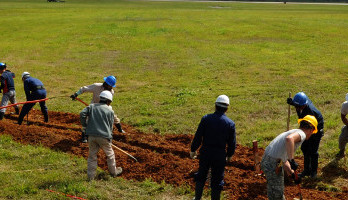Join hands to build a bit of the Internet
June 15, 2017
on
on

Last week I was at EuroDIG in Tallinn (Estonia). The European Dialogue on Internet Governance is held every year. All interested persons are welcome to come and talk about the evolution of the Internet. The Internet operates on the basis of the multi-stakeholder model and does not have a central administrative authority. In other words, every stakeholder can contribute their ideas and help to make decisions. Since end users are also stakeholders, in Europe that means just about everybody. There are various platforms where discussions of this sort take place, and EuroDIG is one of them at the European level.
A lot of issues and concerns were raised at EuroDIG, including erosion of privacy and insufficient cyber security. However, there were also topics on the positive side, such as community networks created by local initiatives. Internet access in Europe is not as good as you might expect. Although most Europeans do have Internet, the quality is not uniformly good. With more and more important services being migrated online, such as e-health and e-governance, a low-speed connection via a dial-up line or satellite link is no longer adequate. In the EU 71 percent of households have a fast connection (at least 30 Mbit/s), but in rural areas the figure is only 28 percent.
Digging trenches
The main reason why rural areas lag behind is that for telecom companies there is no viable business model for providing fiber optic networks in areas with low population density. Community networks are a way to remedy this situation. One example is B4rn in Britain, a community-operated Internet service provider. The residents literally dig their own trenches for the underground fiber optic cables. In return they receive an impressive 1 Gbit/s connection for £30 per month.
In the multi-stakeholder model, the stakeholders are usually divided into four categories: government bodies, industry, the technical community and the civil community. These four groups do not always agree with each other. However, at EuroDIG they were all enthusiastic about community networks and prepared to cooperate. The role of the telecom companies is to connect the local networks to the rest of the Internet. The European Commission (EC) makes subsidies available. In addition, Broadband Competence Offices which can assist with advice and technical expertise are being set up in EU member states. The citizens concerned are also happy. Not only because they have a fast Internet connection, but also because the project helps bring the community closer together.
Image: The “Cable Dawgs” of the 18th Communications Squadron laying fiber optic cables at Kadena air field in Japan. Photo by Airman 1st Class Keith James. Provided by U.S. Air Force.
A lot of issues and concerns were raised at EuroDIG, including erosion of privacy and insufficient cyber security. However, there were also topics on the positive side, such as community networks created by local initiatives. Internet access in Europe is not as good as you might expect. Although most Europeans do have Internet, the quality is not uniformly good. With more and more important services being migrated online, such as e-health and e-governance, a low-speed connection via a dial-up line or satellite link is no longer adequate. In the EU 71 percent of households have a fast connection (at least 30 Mbit/s), but in rural areas the figure is only 28 percent.
Digging trenches
The main reason why rural areas lag behind is that for telecom companies there is no viable business model for providing fiber optic networks in areas with low population density. Community networks are a way to remedy this situation. One example is B4rn in Britain, a community-operated Internet service provider. The residents literally dig their own trenches for the underground fiber optic cables. In return they receive an impressive 1 Gbit/s connection for £30 per month.
In the multi-stakeholder model, the stakeholders are usually divided into four categories: government bodies, industry, the technical community and the civil community. These four groups do not always agree with each other. However, at EuroDIG they were all enthusiastic about community networks and prepared to cooperate. The role of the telecom companies is to connect the local networks to the rest of the Internet. The European Commission (EC) makes subsidies available. In addition, Broadband Competence Offices which can assist with advice and technical expertise are being set up in EU member states. The citizens concerned are also happy. Not only because they have a fast Internet connection, but also because the project helps bring the community closer together.
Image: The “Cable Dawgs” of the 18th Communications Squadron laying fiber optic cables at Kadena air field in Japan. Photo by Airman 1st Class Keith James. Provided by U.S. Air Force.
Read full article
Hide full article

About Tessel Renzenbrink
Tessel Renzenbrink is a freelance writer with a focus on the impact of technology on society. She is especially interested in information technology and the transition to a low carbon energy system. For Elektor she is the editor of the columns Elektor Ethics a... >>


Discussion (0 comments)